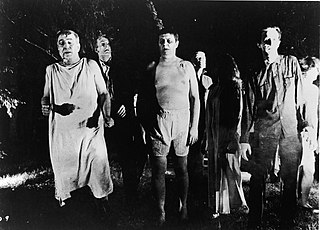Related Research Articles
A television film, alternatively known as a television movie, made-for-TV film/movie, telefilm, telemovie or TV film/movie, is a feature-length film that is produced and originally distributed by or to a television network, in contrast to theatrical films made for initial showing in movie theaters, and direct-to-video films made for initial release on home video formats. In certain cases, such films may also be referred to and shown as a miniseries, which typically indicates a film that has been divided into multiple parts or a series that contains a predetermined, limited number of episodes.

Netflix is an American subscription video on-demand over-the-top streaming service. The service primarily distributes original and acquired films and television shows from various genres, and it is available internationally in multiple languages.

2929 Entertainment, LLC. is an American integrated media and entertainment company co-founded by billionaire entrepreneurs Todd Wagner and Mark Cuban. 2929 maintains companies and interests across several industries including entertainment development and packaging, film and television production and distribution, digital and broadcast syndication, theatrical exhibition, and home entertainment.
Nickelodeon Movies Inc. is an American film production company owned by Paramount Global. Originally founded in 1995, it serves as both the film production arm of the American children's network Nickelodeon and the family film distribution label of Paramount Pictures, operating under its Paramount Players division.
Empire International Pictures was an American independent small-scale theatrical distribution company. Charles Band formed Empire in 1983, prompted by his dissatisfaction with distributors' handling of films made by his previous business, Charles Band International Productions. Empire produced and distributed a number of low-budget horror and fantasy feature films, including Re-Animator, Troll, Ghoulies, Trancers, and From Beyond.

An animation studio is a company producing animated media. The broadest such companies conceive of products to produce, own the physical equipment for production, employ operators for that equipment, and hold a major stake in the sales or rentals of the media produced. They also own rights over merchandising and creative rights for characters created/held by the company, much like authors holding copyrights. In some early cases, they also held patent rights over methods of animation used in certain studios that were used for boosting productivity. Overall, they are business concerns and can function as such in legal terms.
Film distribution, also called film exhibition or film distribution and exhibition, is the process of making a movie available for viewing to an audience. This is normally the task of a professional film distributor, who would determine the marketing and release strategy for the film, the media by which a film is to be exhibited or made available for viewing and other matters. The film may be exhibited directly to the public either through a movie theater or television, or personal home viewing. For commercial projects, film distribution is usually accompanied by film promotion.

Freestyle Releasing, LLC is an American independent film distribution company based in Los Angeles, California, founded in 2004, specializing in releasing low budget films theatrically. Unlike most distributors, Freestyle Releasing does not put up any prints and advertising money for its releases, leaving advertising costs to production companies.
A simultaneous release, also known as a day-and-date release, is the release of a film on multiple platforms—most commonly theatrical and home video—on the exact same day, or in very close proximity to each other. This is in contrast to the industry standard of having a window of exclusivity between the theatrical and home video releases.

Cinematic exhibition of the B movie, defined as a relatively low-cost genre film, has declined substantially from the early 1980s to the present. Spurred by the historic success of several big-budget movies with B-style themes beginning in the mid-1970s, the major Hollywood studios moved progressively into the production of A-grade films in genres that had long been low-budget territory. With the majors also adopting exploitation-derived methods of booking and marketing, B movies began to be squeezed out of the commercial arena. The advent of digital cinema in the new millennium appeared to open up new opportunities for the distribution of inexpensive genre movies.

China Film Group Corporation (CFGC) is the largest, most influential film enterprise in the People's Republic of China, owned by the Central Propaganda Department of the Chinese Communist Party. According to Forbes, it is a state monopoly that all imported films have to work with. It also runs theaters and finances, produces, and distributes films. In 2014, the company was the largest film distributor in China, with 32.8% of the market.

Home video is recorded media sold or rented for home viewing. The term originates from the VHS and Betamax era, when the predominant medium was videotapes, but has carried over to optical disc formats such as DVD and Blu-ray. In a different usage, "home video" refers to amateur video recordings, also known as home movies. Another format LaserDisc is also a home video format released in 1978 which never caught on market due to high cost of the players and their inability to record TV programs unlike the VHS. The format gained interests from movie collectors.

Paramount Animation is an American animation studio, serving as the animation division and label of Paramount Pictures, a subsidiary of Paramount Global. The division was founded on July 6, 2011, following the box office success of Paramount's own Rango and the end of their distribution deal with DreamWorks Animation in 2012.

Shaun the Sheep Movie is a 2015 stop-motion animated adventure comedy film written and directed by Richard Starzak and Mark Burton. It is based on the British television series Shaun the Sheep, in turn a spin-off of the Wallace and Gromit film A Close Shave (1995). Starring the voices of Justin Fletcher, John Sparkes, and Omid Djalili, the film follows Shaun and his flock navigating the big city to save their amnesiac farmer, while an overzealous animal control worker pursues the group. It was produced by Aardman Animations, and financed by StudioCanal in association with Anton Capital Entertainment.

The SpongeBob Movie: Sponge on the Run is a 2020 American adventure comedy film based on the animated television series SpongeBob SquarePants. Written and directed by series co-developer and former writer Tim Hill, who co-wrote the story with Jonathan Aibel and Glenn Berger, it stars the series' regular voice cast and includes new characters performed by Awkwafina, Snoop Dogg, Tiffany Haddish, Keanu Reeves, Danny Trejo, and Reggie Watts. The film follows SpongeBob on his quest to rescue his pet snail, Gary, after he is kidnapped. The film is dedicated to creator Stephen Hillenburg, who died in 2018, and also served as an executive producer on the project. It is the third theatrical film based on the series, following the first in 2004 and second in 2015

Captain Underpants: The First Epic Movie is a 2017 American animated superhero comedy film based on Dav Pilkey's children's novel series Captain Underpants, produced by DreamWorks Animation and distributed by 20th Century Fox. It was directed by David Soren from a screenplay by Nicholas Stoller, and stars the voices of Kevin Hart, Ed Helms, Thomas Middleditch, Nick Kroll, Jordan Peele, and Kristen Schaal. The film was released during the 20th anniversary of the Captain Underpants series. In the film, fourth-grade pranksters George and Harold hypnotize their humorless principal Mr. Krupp into thinking he is a superhero named Captain Underpants. The movie loosely adapts the first, second, fourth, and eleventh Captain Underpants books.

The COVID-19 pandemic had a negative effect on certain films in the early 2020s, mirroring its impacts across all arts sectors. Across the world, and to varying degrees, cinemas and movie theaters were closed, festivals were cancelled or postponed, and film releases were moved to future dates or delayed indefinitely. Due to cinemas and movie theaters closing, the global box office dropped by billions of dollars, streaming saw a significant increase in popularity, and the stock of film exhibitors dropped dramatically. Many blockbusters originally scheduled to be released by mid-March 2020 were postponed or canceled around the world, with film productions also being halted. This in turn created openings for independent cinema productions to receive wider exposure.
References
- ↑ Alvarez, Max J (30 December 1994). "Big Names Look For Bright Lights In Videoland". Chicago Tribune . Retrieved 7 December 2010.
- 1 2 Clements, Jonathan; McCarthy, Helen (9 February 2015). The Anime Encyclopedia, 3rd Revised Edition: A Century of Japanese Animation (Third ed.). Stone Bridge Press. pp. 195–196. ISBN 978-1-61172-018-1.
- ↑ Lerman, Laurence (17 September 2001). "Independents' 'Bread and Butter'". Video Business. 21 (38). Section: Video Premieres.
- 1 2 3 DVD Exclusive Online. "Stars, Money Migrate To DVDP (archived)". Archived from the original on 15 May 2006. Retrieved 13 January 2007.
- ↑ Barlow, Aaron (2005). The DVD Revolution: Movies, Culture, and Technology. Praeger/Greenwood. pp. 19. ISBN 0-275-98387-0.
Films that flop in theaters or which are never theatrically released can prove profitable through longer-term video and DVD sales.
- 1 2 3 4 Alvarez, Max J. (30 December 1994). "Big Names Look For Bright Lights In Videoland". Chicago Tribune . Retrieved 22 July 2018.
- ↑ Kleiman, Rena (28 November 1983). "Premiere made-for-home-video feature firmed for production". The Hollywood Reporter . p. 1.
- ↑ "E. Nick". IMDb. Retrieved 30 January 2024.
- ↑ Goodale, Gloria (23 October 1998). "'Straight to Video' Picks up Steam". Christian Science Monitor .
- ↑ Bernstein, Adam (12 December 2004). "Silent Films Speak Loudly for Hughes". The Washington Post . TVWeek p. Y06.
- 1 2 "More Films Jump Straight to DVD". USA Today . 6 August 2003. Section: Life, p. 03d.
- ↑ Connors, Martin; Jim Craddock (2000), "Tiny Toon Adventures: How I Spent My Vacation", VideoHound's Golden Movie Retriever 2000, Farmington Hills: Thomson Gale, p. 923, ISBN 978-1-57859-042-1
- ↑ Ellin, Harlene (24 December 1998). "The mystery of 'NIMH II': Why did they even bother?" . Chicago Tribune. Tribune Company. p. 7.B. Retrieved 26 April 2024.[ dead link ]
- ↑ Delgado, Mariana (1 September 2021). "Why 'Scooby-Doo on Zombie Island' Is One of the Best & Scariest Films of the Franchise". Collider. Retrieved 26 April 2024.
- ↑ Matzer, Marla (16 April 1997). "Direct-to-Video Family Films Are Hitting Home". Los Angeles Times . Retrieved 4 June 2011.
- ↑ Justice League: Crisis on Two Earths gets big-screen Premieres on Two Coasts – Comicmix.com – February 5, 2010
- ↑ Berardinelli, James. "DVD's Scarlet Letter" . Retrieved 13 January 2007.
- ↑ For one example of the term "DVDP" in use, see "Paramount grows DVDP slate". Archived from the original on 14 May 2006. Retrieved 13 January 2007.
- ↑ Mueller, Anne (23 June 2011). "Why Movies Cost So Much to Make". Investopedia US. IAC. Retrieved 24 July 2014.. As of 2007 [update] , the average production cost was $65 million, and distribution and marketing added about another $35 million, for a total of around $100 million
- ↑ Hettrick, Scott (2 January 2005). "Spending on DVDs up 10%". Variety . Archived from the original on 5 November 2012. Retrieved 13 January 2007.
- ↑ Halbfinger, David M. (23 October 2007). "Facing Competition, iTunes Revs Up Its Film Section". The New York Times . Retrieved 25 August 2011.
- ↑ Graser, Marc (25 October 2007). "Ed Burns offers 'Violets' on iTunes: Feature to skip theatrical release". Variety . Archived from the original on 16 May 2012. Retrieved 25 August 2011.
- ↑ Kirsner, Scott (2 November 2007). "Studio's Digital Dilemma: Apple Calling Shots as Biz Tries To Control Market". Variety . Archived from the original on 11 November 2010. Retrieved 26 August 2011.
- ↑ Tibken, Shara. "Netflix gets its first Oscars nod with 'The Square'". CNET. Retrieved 6 May 2020.
- ↑ McNary, Dave (2 March 2015). "Netflix Makes Another Bigscreen Splash With 'Beasts of No Nation'". Variety. Retrieved 3 March 2015.
- ↑ Fleming, Mike Jr. (7 July 2015). "Netflix Dates First Feature Film Slate With Idris Elba, Cary Fukunaga, Adam Sandler, Harvey Weinstein, Paul Reubens & Judd Apatow". Deadline. Retrieved 17 March 2020.
- ↑ "Movie Chains Balk At Netflix's Plan For Simultaneous Release". NPR.org. Retrieved 17 March 2020.
- ↑ Lee, Dami (27 August 2019). "Netflix will release 10 fall films in theaters before they stream". The Verge. Retrieved 18 March 2020.
- ↑ Lang, Brent (4 March 2019). "Netflix Responds to Steven Spielberg's Push to Bar It From Oscars". Variety. Retrieved 3 April 2019.
- ↑ Wallenstein, Andrew (24 December 2014). "What is Kernel? The Stealth Startup Sony Tapped to Stream 'The Interview' (Exclusive)". Variety. Retrieved 17 March 2020.
- ↑ "'The Interview' Release Back On For Christmas Day – Update". Deadline Hollywood. December 23, 2014. Archived from the original on December 23, 2014. Retrieved December 23, 2014.
- ↑ Frater, Patrick (24 January 2020). "China's 'Lost in Russia' Switches to Unprecedented Online Release in Response to Coronavirus Outbreak". Variety. Retrieved 6 May 2020.
- ↑ D'Alessandro, Anthony (14 April 2020). "'Trolls World Tour': Drive-In Theaters Deliver What They Can During COVID-19 Exhibition Shutdown – Easter Weekend 2020 Box Office". Deadline. Retrieved 14 April 2020.
- ↑ D'Alessandro, Anthony (21 April 2020). "'Scoob!' To Skip Theaters & Head Into Homes; How Director Tony Cervone Got Animated Pic Across The Finish Line In COVID-19 Climate". Deadline Hollywood. Retrieved 21 April 2020.
- ↑ N'Dukao, Amanda (4 May 2020). "Focus Features Sets Digital Release For 'The High Note' Starring Tracee Ellis Ross & Dakota Johnson". Deadline Hollywood. Retrieved 5 May 2020.
- ↑ Spangler, Todd (17 April 2020). "'Artemis Fowl' Premiere Date on Disney Plus Set as Movie Goes Direct-to-Streaming". Variety. Retrieved 6 May 2020.
- ↑ D'Alessandro, Anthony (27 April 2020). "Seth Rogen Comedy 'An American Pickle' Jumps From Sony To HBO Max". Deadline Hollywood. Retrieved 27 April 2020.
- ↑ D'Alessandro, Anthony (20 March 2020). "Kumail Nanjiani & Issa Rae Comedy 'The Lovebirds' To Nest At Netflix". Deadline. Retrieved 6 May 2020.
- ↑ D'Alessandro, Anthony (8 April 2020). "'My Spy': STX Dave Bautista Action Comedy Acquired By Amazon Studios For Streaming". Deadline. Retrieved 6 May 2020.
- 1 2 DustinKop (12 February 2016). "A Look at the 1980's Anime OVA Legacy". the-artifice.com. The Artifice. Archived from the original on 30 September 2020. Retrieved 10 February 2021.
- 1 2 Sevakis, Justin. "Why Did So Many OVA Series End Prematurely?". animenewsnetwork.com. Anime News Network. Retrieved 10 February 2021.
- 1 2 Balmont, James. "How V-Cinema sparked a Japanese filmmaking revolution". lwlies.com. Little White Lies . Retrieved 10 February 2021.
- 1 2 Mes, Tom. "The V-Cinema Notebook, Part 1". midnighteye.com. Midnight Eye . Retrieved 10 February 2021.
- 1 2 Macias, Patrick (15 November 2019). "The Harajuku Line: Forgotten Fashion Monsters of Japanese V-Cinema". medium.com. Medium . Retrieved 10 February 2021.
- 1 2 "你可能没注意到的网络大电影正在崛起".
- ↑ "低成本网络大电影的制作秘籍". Archived from the original on 14 April 2021. Retrieved 14 April 2021.
- ↑ "预算占比30%,投入近百万:网络大电影进入"营销时代"".
- ↑ "网络大电影"爆发" 市场规模有望达10亿". Sohu .
- ↑ "他们曾经都大红大紫过,如今沦落到拍网络电影令人唏嘘". Sohu .
- ↑ "Q1Q2 Movie Channel Official". YouTube .
- ↑ "YOUKU MOVIE". YouTube .